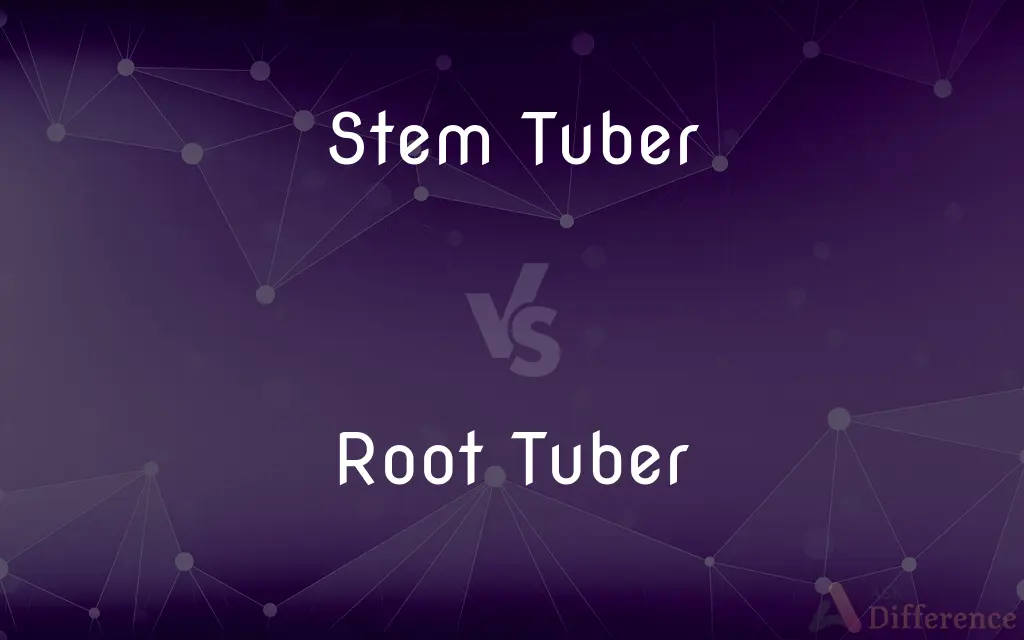Stem Tuber vs. Root Tuber — What's the Difference?
By Tayyaba Rehman — Published on November 10, 2023
Stem Tubers are enlarged structures formed from stems, while Root Tubers are enlargements of roots for nutrient storage.

Difference Between Stem Tuber and Root Tuber
Table of Contents
ADVERTISEMENT
Key Differences
Stem Tubers and Root Tubers are both specialized structures in plants designed for nutrient storage.
A Stem Tuber is an enlarged portion of a stem, often underground, which stores nutrients and possesses buds called "eyes" from which new plants can grow. Conversely, a Root Tuber is an enlarged section of a root that serves a similar storage purpose but lacks these eyes.
One can often determine the type of tuber by its location and features.
Stem Tubers are typically found close to the soil's surface and display growth nodes or eyes. Root Tubers, however, delve deeper into the soil and have a smoother appearance without distinct eyes.
While both types of tubers are used by plants to survive harsh conditions, they originate from different plant parts.
ADVERTISEMENT
Stem Tubers arise from thickened rhizomes or stolons, while Root Tubers are directly enlarged roots.
In terms of human consumption, both types of tubers offer nutritional value.
Potatoes are a common example of Stem Tubers, while sweet potatoes are representative of Root Tubers.
Comparison Chart
Origin
Enlarged stem sections
Enlarged root sections
Growth Nodes
Have "eyes" or growth nodes
Typically smooth, without distinct eyes
Depth in Soil
Generally closer to the soil surface
Often situated deeper in the soil
Examples
Potatoes
Sweet potatoes, yams
Function
Nutrient storage and new plant growth
Primarily nutrient storage
Compare with Definitions
Stem Tuber
A modified stem that stores food and can generate new plants.
Each eye on a Stem Tuber can give rise to a new potato plant.
Root Tuber
An enlargement of certain roots for storage purposes.
Sweet potatoes are a type of Root Tuber.
Stem Tuber
An enlarged stem portion storing nutrients.
The potato plant forms a Stem Tuber underground.
Root Tuber
A modified root that serves as a nutrient reserve.
The Root Tuber of the sweet potato plant is rich in vitamins and minerals.
Stem Tuber
A thickened section of the stem, usually underground.
The eyes on a potato indicate its nature as a Stem Tuber.
Root Tuber
A type of root that has evolved to store large amounts of nutrients.
The cassava plant has a Root Tuber that is a primary food source in some regions.
Stem Tuber
The part of certain plants that is often consumed as a vegetable.
The edible part of the potato plant is its Stem Tuber.
Root Tuber
Underground structures storing energy in the form of starch.
Root Tubers like yams are staples in many diets around the world.
Stem Tuber
A structure that helps plants survive unfavorable conditions.
During winter, the potato plant relies on the nutrients stored in its Stem Tuber.
Root Tuber
The underground, edible part of some plants.
The carrot is a type of Root Tuber consumed worldwide.
Common Curiosities
Is the potato a Stem Tuber or Root Tuber?
The potato is a Stem Tuber.
Can I tell them apart by their appearance?
Yes, Stem Tubers usually have "eyes" or growth nodes, while Root Tubers are typically smoother.
Are Stem Tubers and Root Tubers both used for storage?
Yes, both types of tubers store nutrients for the plant.
Can both types give rise to new plants?
Stem Tubers can directly give rise to new plants from their eyes, while Root Tubers primarily store nutrients.
What about the sweet potato?
The sweet potato is a Root Tuber.
Are there any nutritional differences between the two types of tubers?
Nutritional content varies by specific plant, not necessarily by whether it's a Stem or Root Tuber.
Do both types of tubers grow underground?
Generally, yes. Both are usually found underground, though at varying depths.
Are all tubers edible?
Not all tubers are edible; some may be toxic or unpalatable.
How deep do Root Tubers typically grow?
Root Tubers generally grow deeper than Stem Tubers, though exact depth can vary based on the species and environment.
Are the terms "bulb" and "Stem Tuber" synonymous?
No, while both are underground storage structures, bulbs and Stem Tubers have different structures and growth patterns.
Do tubers play a role in plant reproduction?
Yes, especially Stem Tubers, which can give rise to new plants from their growth nodes or eyes.
How long can plants rely on their tubers for nutrition?
It varies, but some plants can rely on their tubers for nutrition throughout entire unfavorable seasons.
Do all plants develop tubers?
No, only certain species of plants develop tubers.
Why do plants develop these tubers?
Tubers are adaptations for nutrient storage, helping plants survive unfavorable conditions.
Can a single plant have both Stem and Root Tubers?
Typically, plants develop either Stem Tubers or Root Tubers, but not both.
Share Your Discovery

Previous Comparison
Crude Oil vs. Natural Gas
Next Comparison
Repetitive DNA vs. Satellite DNAAuthor Spotlight
Written by
Tayyaba RehmanTayyaba Rehman is a distinguished writer, currently serving as a primary contributor to askdifference.com. As a researcher in semantics and etymology, Tayyaba's passion for the complexity of languages and their distinctions has found a perfect home on the platform. Tayyaba delves into the intricacies of language, distinguishing between commonly confused words and phrases, thereby providing clarity for readers worldwide.












































